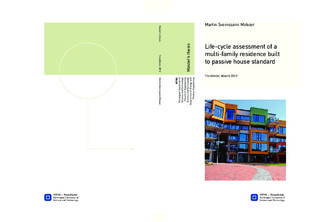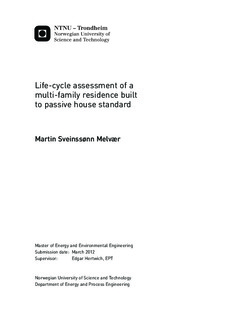| dc.contributor.advisor | Hertwich, Edgar | nb_NO |
| dc.contributor.advisor | Wiberg, Aoife Anne Marie | nb_NO |
| dc.contributor.author | Melvær, Martin Sveinssønn | nb_NO |
| dc.date.accessioned | 2014-12-19T11:48:40Z | |
| dc.date.available | 2014-12-19T11:48:40Z | |
| dc.date.created | 2012-11-08 | nb_NO |
| dc.date.issued | 2012 | nb_NO |
| dc.identifier | 565856 | nb_NO |
| dc.identifier | ntnudaim:6405 | nb_NO |
| dc.identifier.uri | http://hdl.handle.net/11250/234717 | |
| dc.description.abstract | LCA of buildings has become a distinguished field of LCA, and a number of previous studies have found that low energy buildings generally have better life cycle performance than conventional buildings. However, there has been a lack of studies comparing low energy buildings against passive buildings. The present study evaluates life cycle performance of two passive and two low energy buildings that are all part of the housing cooperative Løvåshagen in Bergen. Construction of the housing cooperative was completed in 2009 and measured material and operational data was used in a comprehensive LCA of the whole life cycle from cradle to grave, for twelve midpoint impact categories. The functional unit is a lifetime of fifty years of one square meter BRA of a building block apartment. Heating for low energy apartments are provided by electric resistance heaters and heating cables in the bathroom floors, while hot water heating is provided by an electric water heater. Evacuated tube thermal collectors are located on the roofs and provide passive house room heating through hydronic radiators and hydronic floor heating. They also provide hot water heating for each apartment. When solar collector output is not sufficient, heating is supplied by electric resistance elements.The LCA results show practically no difference between the climate change performances of the house models, and this is largely the result of a particularly low passive house performance. In simulation-based LCA literature there appears to be a trend of over-estimating the operational performance of passive and low energy buildings, and Løvåshagen is no exception. The measured electricity consumption is high, both compared to estimations and to the results of other, simulation-based, studies. The high consumption appears to be a result of a particularly low outdoor temperature for the year of the measured data. It is recommended to monitor the electricity consumption over the next few years of operation, and if it is not significantly reduced there is reason to suspect faults in building construction or in the solar collector system. In the case of no direct defects there is reason to re-evaluate the effectiveness of solar collectors for the climatic conditions of Bergen. | nb_NO |
| dc.language | eng | nb_NO |
| dc.publisher | Institutt for energi- og prosessteknikk | nb_NO |
| dc.subject | ntnudaim:6405 | no_NO |
| dc.subject | MTENERG energi og miljø | no_NO |
| dc.subject | Energibruk og energiplanlegging | no_NO |
| dc.title | Life-cycle assessment of a multi-family residence built to passive house standard | nb_NO |
| dc.type | Master thesis | nb_NO |
| dc.source.pagenumber | 90 | nb_NO |
| dc.contributor.department | Norges teknisk-naturvitenskapelige universitet, Fakultet for ingeniørvitenskap og teknologi, Institutt for energi- og prosessteknikk | nb_NO |

